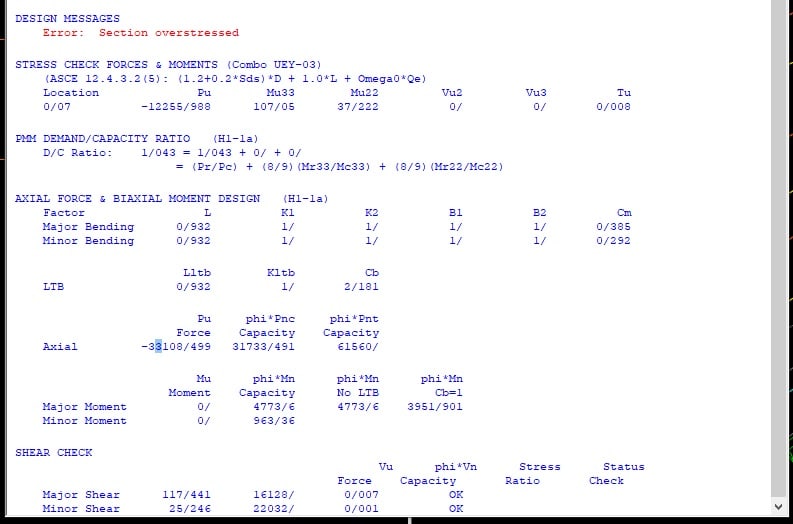Hi everyone
So I'm getting an overstress error for a column in SAP2000 and when I check the data I have:
STRESS CHECK FORCES & MOMENTS (Combo UEY-03)
(ASCE 12.4.3.2(5): (1.2+0.2*Sds)*D + 1.0*L + Omega0*Qe)
Location Pu Mu33 Mu22 Vu2 Vu3 Tu
0/07 -12255/988 107/05 37/222 0/ 0/ 0/008
so that means I have an axial force of -12255 with the defined load combination of UEY-03 right?
but then a few lines down under, I get this:
AXIAL FORCE & BIAXIAL MOMENT DESIGN (H1-1a)
Factor L K1 K2 B1 B2 Cm
Major Bending 0/932 1/ 1/ 1/ 1/ 0/385
Minor Bending 0/932 1/ 1/ 1/ 1/ 0/292
Lltb Kltb Cb
LTB 0/932 1/ 2/181
Pu phi*Pnc phi*Pnt
Force Capacity Capacity
Axial -33108/499 31733/491 61560/
If I'm understanding right this suggests that the column has a capacity of 31733 ,but the axial force is as much as -33108? but how? what do phi*pnc and phi*pnt means? how did PU jump from -12255 to -33108?

So I'm getting an overstress error for a column in SAP2000 and when I check the data I have:
STRESS CHECK FORCES & MOMENTS (Combo UEY-03)
(ASCE 12.4.3.2(5): (1.2+0.2*Sds)*D + 1.0*L + Omega0*Qe)
Location Pu Mu33 Mu22 Vu2 Vu3 Tu
0/07 -12255/988 107/05 37/222 0/ 0/ 0/008
so that means I have an axial force of -12255 with the defined load combination of UEY-03 right?
but then a few lines down under, I get this:
AXIAL FORCE & BIAXIAL MOMENT DESIGN (H1-1a)
Factor L K1 K2 B1 B2 Cm
Major Bending 0/932 1/ 1/ 1/ 1/ 0/385
Minor Bending 0/932 1/ 1/ 1/ 1/ 0/292
Lltb Kltb Cb
LTB 0/932 1/ 2/181
Pu phi*Pnc phi*Pnt
Force Capacity Capacity
Axial -33108/499 31733/491 61560/
If I'm understanding right this suggests that the column has a capacity of 31733 ,but the axial force is as much as -33108? but how? what do phi*pnc and phi*pnt means? how did PU jump from -12255 to -33108?

